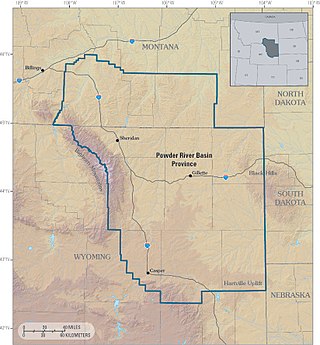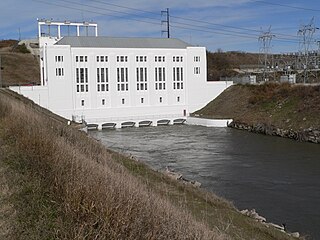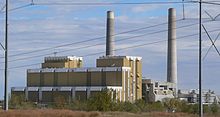
Electricity generation is the process of generating electric power from sources of primary energy. For utilities in the electric power industry, it is the stage prior to its delivery to end users or its storage, using for example, the pumped-storage method.

Columbus is the county seat of Platte County, Nebraska, situated at the confluence of the Loup and Platte rivers roughly 85 miles west-northwest of Omaha and 75 miles northwest of Lincoln by road, near the county's southern edge. With an estimated population of 24,464 as of 2024, it is the 10th-most populous city in Nebraska.
The Central Electricity Generating Board (CEGB) was responsible for electricity generation, transmission and bulk sales in England and Wales from 1958 until privatisation of the electricity industry in the 1990s.

The Powder River Basin is a geologic structural basin in southeast Montana and northeast Wyoming, about 120 miles (190 km) east to west and 200 miles (320 km) north to south, known for its extensive coal reserves. The former hunting grounds of the Oglala Lakota, the area is very sparsely populated and is known for its rolling grasslands and semiarid climate.
Puget Sound Energy, Inc. (PSE) is an energy utility company based in the U.S. state of Washington that provides electrical power and natural gas to the Puget Sound region. The utility serves electricity to more than 1.2 million customers in Island, King, Kitsap, Kittitas, Pierce, Skagit, Thurston, and Whatcom counties, and provides natural gas to 877,000 customers in King, Kittitas, Lewis, Pierce, Snohomish and Thurston counties. The company's electric and natural gas service area spans 6,000 square miles (16,000 km2).

Cooper Nuclear Station (CNS) is a boiling water reactor (BWR) type nuclear power plant located on a 1,251-acre (506 ha) site near Brownville, Nebraska between Missouri River mile markers 532.9 and 532.5, on Nebraska's border with Missouri. It is the largest single-unit electrical generator in Nebraska.
Nebraska Public Power District (NPPD) is the largest electric utility in the state of Nebraska, serving all or parts of 84 counties. It was formed on January 1, 1970, when Consumers Public Power District, Platte Valley Public Power and Irrigation District (PVPPID) and Nebraska Public Power System merged to become Nebraska Public Power District. NPPD's predecessors were created through the efforts of the Nebraska legislature and financial agent Guy L. Myers as part of a system where all the investor-owned utilities operating in the state of Nebraska were condemned and their properties turned over to 'public power districts' being created at the time. NPPD is a public corporation and political subdivision of the state of Nebraska. The utility is governed by an 11-member Board of Directors, who are popularly elected from NPPD's chartered territory.

The Nebraska Kansas Colorado Railway, formerly the Nebraska, Kansas and Colorado RailNet, is based in Grant, Nebraska, and operates about 509 miles (819 km) of track in southwestern Nebraska, northern Kansas and northeastern Colorado. It carries mainly agricultural-related products, especially grains, as well as coal to the Nebraska Public Power District's Gerald Gentleman Station which is Nebraska's largest coal-fired power plant. It is owned by OmniTRAX.
WEC Energy Group is an American company based in Milwaukee, Wisconsin that provides electricity and natural gas to 4.4 million customers across four states.

The Loup Canal is a hydroelectric and irrigation canal located in eastern Nebraska, United States. The canal is owned and managed by Loup Power District, a public power electric utility.

Omaha Public Power District (OPPD) is a public electric utility in the state of Nebraska. It is wholly owned by the Nebraska state government, and controlled by a special district. OPPD serves more than 855,000 people in Omaha and 13 surrounding counties in southeast eastern. OPPD was formed in 1946 as a political subdivision of the State of Nebraska, taking over the operations of the privately owned Nebraska Power Company. Nebraska is the only US state in which all electric utilities are government owned. A publicly elected eight-member Board of Directors sets rates and policies.

Roosecote Power Station was a gas-fired, originally coal-fired power station, situated in the Roosecote district of Barrow-in-Furness in Cumbria, North West England. The gas-fired station opened in 1991 and was the first CCGT power station to supply electricity to the United Kingdom's National Grid, but was mothballed in 2012 after a proposed biomass power station was cancelled. It was situated directly adjacent to Rampside Gas Terminal. The plant was demolished between 2014 and 2015. The site is now a 49 MW battery storage facility.

NTPC Limited, formerly known as National Thermal Power Corporation, is an Indian central Public Sector Undertaking (PSU) under the ownership of the Ministry of Power and the Government of India, who is engaged in the generation of electricity and other activities. The headquarters of the PSU are situated at New Delhi. NTPC's core function is the generation and distribution of electricity to State Electricity Boards in India. The body also undertakes consultancy and turnkey project contracts that involve engineering, project management, construction management, and operation and management of power plants.

The Moran Municipal Generation Station is a former 30-megawatt power plant known for its architecture and innovation built in Burlington, Vermont from 1952 to 1955. It is now a derelict structure that will be redeveloped to encourage year-round use, economic activity and public access. The Moran Plant is located at 475 Lake Street on the Burlington waterfront. It is named for Burlington mayor J.E. Moran.

The R. Paul Smith Power Station is a closed electric generating plant owned by FirstEnergy in Williamsport, Maryland.
Sheldon Power Station is a coal-fired power station located near Hallam, Nebraska. It is the site of the former Hallam Nuclear Generating Station which operated from 1962 to 1964.
Platte Generating Station is a single unit 100 MW (megawatt) coal-fired power plant owned and operated by the City of Grand Island located in Grand Island, Nebraska. The plant entered commercial service in 1982.

The Bison Solar Plant, also known as the Rawhide Flats Solar Plant, is a 30 megawatt (MWAC) photovoltaic power station in Larimer County, Colorado located about 10 miles (16 km) north of the town of Wellington. The plant is notable for being one of the first in the U.S. built to a 1500 Volt system specification. The electricity is being sold to the Platte River Power Authority (PRPA) under a 25-year power purchase agreement.












